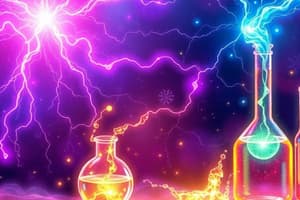Podcast
Questions and Answers
What is the primary process that occurs during electrolysis?
What is the primary process that occurs during electrolysis?
- Heating a compound until it naturally decomposes into its elements.
- Physical separation of a compound's elements without chemical change.
- Passing an electric current through a compound to chemically separate its components. (correct)
- Mixing a compound with a solvent to dissolve and isolate its elements.
Which of the following components are essential for electrolysis to occur?
Which of the following components are essential for electrolysis to occur?
- A strong magnet, a non-conductive container, and distilled water.
- A power supply, electrodes, and an electrolyte. (correct)
- A heating element, a catalyst, and a pure metal sample.
- A vacuum chamber, inert gas, and a radioactive isotope.
What role do mobile ions play in the process of electrolysis?
What role do mobile ions play in the process of electrolysis?
- They neutralize the electrodes, preventing unwanted reactions.
- They increase the temperature of the electrolyte to speed up the reaction.
- They prevent electrical conductivity within the electrolyte.
- They act as mobile charge carriers to conduct electricity through the electrolyte. (correct)
In an electrolytic cell, what energy conversion takes place?
In an electrolytic cell, what energy conversion takes place?
What occurs at the anode during electrolysis?
What occurs at the anode during electrolysis?
Why can ionic compounds conduct electricity in molten or aqueous states but not in the solid state?
Why can ionic compounds conduct electricity in molten or aqueous states but not in the solid state?
What is the ultimate result of anions and cations being oxidized and reduced respectively during the electrolysis process?
What is the ultimate result of anions and cations being oxidized and reduced respectively during the electrolysis process?
What is the role of inert electrodes in electrolysis?
What is the role of inert electrodes in electrolysis?
Why is water considered a 'universal solvent' in the context of electrolysis?
Why is water considered a 'universal solvent' in the context of electrolysis?
In an aqueous solution containing multiple cations and anions, what determines which ions are discharged?
In an aqueous solution containing multiple cations and anions, what determines which ions are discharged?
How does the concentration of an aqueous solution affect the selective discharge of anions?
How does the concentration of an aqueous solution affect the selective discharge of anions?
What happens to the electrolyte solution during the electrolysis of dilute copper(II) sulfate ($CuSO_4$) using inert electrodes?
What happens to the electrolyte solution during the electrolysis of dilute copper(II) sulfate ($CuSO_4$) using inert electrodes?
In the electrolysis of dilute sodium chloride solution, what is the ratio of hydrogen ($H_2$) to oxygen ($O_2$) produced?
In the electrolysis of dilute sodium chloride solution, what is the ratio of hydrogen ($H_2$) to oxygen ($O_2$) produced?
Why does the solution become alkaline during the electrolysis of concentrated sodium chloride?
Why does the solution become alkaline during the electrolysis of concentrated sodium chloride?
What indicates that a solution has become alkaline during the electrolysis of concentrated sodium chloride, using Universal Indicator?
What indicates that a solution has become alkaline during the electrolysis of concentrated sodium chloride, using Universal Indicator?
In the electrolysis of concentrated hydrochloric acid ($HCl$), what is the ratio of hydrogen gas ($H_2$) to chlorine gas ($Cl_2$) produced?
In the electrolysis of concentrated hydrochloric acid ($HCl$), what is the ratio of hydrogen gas ($H_2$) to chlorine gas ($Cl_2$) produced?
What happens to the concentration of hydrochloric acid during the electrolysis of concentrated $HCl$?
What happens to the concentration of hydrochloric acid during the electrolysis of concentrated $HCl$?
Which of the following is a disadvantage of using graphite as an electrode in electrolysis?
Which of the following is a disadvantage of using graphite as an electrode in electrolysis?
Which of the following is an advantage of using platinum as an electrode in electrolysis?
Which of the following is an advantage of using platinum as an electrode in electrolysis?
What is meant by the term 'selective discharge' in the context of electrolysis?
What is meant by the term 'selective discharge' in the context of electrolysis?
Flashcards
What is Electrolysis?
What is Electrolysis?
The process of passing an electric current through a compound to chemically separate its components.
What is an Electrolytic Cell?
What is an Electrolytic Cell?
A device that converts electrical energy into chemical energy, facilitating electrolysis.
What is an Electrolyte?
What is an Electrolyte?
An electrically conductive substance (molten or aqueous) containing mobile ions that act as charge carriers.
What are Inert Electrodes?
What are Inert Electrodes?
Signup and view all the flashcards
What does 'Molten' mean?
What does 'Molten' mean?
Signup and view all the flashcards
Molten Binary Ionic Compound
Molten Binary Ionic Compound
Signup and view all the flashcards
Reactivity Series
Reactivity Series
Signup and view all the flashcards
Electrochemical Series
Electrochemical Series
Signup and view all the flashcards
Electrolysis of conc. NaCl
Electrolysis of conc. NaCl
Signup and view all the flashcards
Study Notes
- Electrolysis is the process of using an electric current to break down a compound chemically.
- It occurs in an electrolytic cell, a device converting electrical energy into chemical energy.
Parts of an Electrolytic Cell
- Power supply: Drives the movement of charges in a circuit.
- Electrodes: Connected to opposite ends of the power supply.
- Electrolyte: Where the electrodes are immersed.
- Electrolyte: An electrically conductive substance (molten or aqueous) with mobile ions that carry charge.
- Electrode: Conduct electricity with delocalized electrons.
- Anode: Positive electrode connected to the positive terminal of the power source.
- Cathode: Negative electrode connected to the negative terminal of the power source.
The Process of Electrolysis
- Charge carriers: Electrons in the external circuit, ions in the electrolyte.
- External Circuit: Electrons move from the negative to the positive terminal of the power supply.
- At the Anode: Anions are attracted, lose electrons, and become oxidized.
- At the Cathode: Cations are attracted, gain electrons, and become reduced.
- Electrolyte: Ion movement "completes" the circuit.
Mobile Ions in Electrolytes
- Electrolysis proves ionic compounds conduct electricity only when molten or aqueous.
- Solid ionic compounds have ions fixed in a lattice, preventing conduction.
- Molten and aqueous states allow ions to move and conduct electricity.
Electrolytic Conductors
- Molten and aqueous states contain mobile positive and negative ions for charge conduction.
- Electrolytes undergo redox reactions at electrodes, forming new substances.
Delocalized Electrons in Electrodes
- Metals and graphite conduct electricity via delocalized electrons.
- Inert electrodes (e.g., graphite, platinum) don't chemically change during electrolysis.
- Metal anodes made of other metals may undergo oxidation.
Electrolysis of Molten Binary Ionic Compounds
- Molten binary ionic compound: Typically a salt with one cation and one anion in a liquid state.
- Electrolysis decomposes compounds. Contamination can occur if the electrodes take part in the process, so Inert electrodes are used.
- Molten binary compounds contain mobile cations and anions. During electrolysis, anions are oxidized and cations are reduced, forming atoms or molecules
- 2Cl-(l) -> Cl2(g) + 2e- (at the anode)
- Na+(l) + e- -> Na(l) (at the cathode)
Determining product ratio
- The number of electrons leaving the electrolyte via the anode is always equal to the number of electrons entering the electrolyte from the cathode.
- The overall reaction for electrolysis is 2NaCl(l) -> 2Na(l) + Cl2(g).
- From this reaction, the ratio of Na to Cl2 produced is 2:1.
Electrolysis of Aqueous Solutions
- Aqueous solution: A solute dissolved in water (the solvent).
- Water: Considered a "universal solvent" and contains H+ and OH- ions from dissociation (H2O(l) ⇌ H+(aq) + OH-(aq)).
- Electrolysis results in multiple cations and anions. Selective discharge determines products.
Selective Discharge of Cations
- Metals are arranged by reactivity.
- More reactive metals have more stable ions, harder to convert back to metal.
- Less reactive metals form ions more easily converted back to the metal.
- It is practically impossible to discharge metals that are above hydrogen in the series from an aqueous solution since all aqueous solutions contain H+ ions.
- During preferential discharge: Metals lower on the reactivity series such as silver (Ag) will be discharged at the cathode. Metals higher on the reactivity series such as Calcium (Ca) are not easily discharged
Selective Discharge of Anions
- They follow electrochemical reactivity. In dilute solutions, the anion lower in series is selectively discharged.
- Anions by ease of discharge: OH− > I− > Br− > Cl− > NO3− > SO42−.
- Solution concentration affects anion discharge. High Cl−, Br−, or I− concentrations increase their dischargeability, potentially overriding the electrochemical series.
- In concentrated NaCl, Cl− ions are selectively discharged instead of OH− ions: 2Cl−(aq) → Cl2(g) + 2e−.
Determining the products
- Determining the products in electrolysis of dilute copper(II) sulfate solution using inert electrodes
- (1) Identify the ions present in the electrolyte: ions from copper(II) sulfate, Cu2+(aq) and SO42-(aq), and ions from water, H+(aq) and OH-(aq)
- (2) Determine the anion discharged at the anode by referring to the electrochemical series. (OH- ions are lower than SO4- ions, and are selectively discharged) 4OH-(aq) -> O2(g) + 2H2O(l) + 4e-
- (3) Determine the cation discharged at the cathode by referring to the reactivity series. (copper is below hydrogen in the reactivity series) Cu2+(aq) + 2e- -> Cu(s)
- (4)Write the overall equation for the reaction Cu2+(aq) + 4OH-(aq) -> 2Cu(s) + O2(g) + 2H2O(l)
- (5) Identify the anion and cation left behind to determine the products in the electrolyte. (H+ and SO42- ions remain, making the solution more acidic)
Electrolysis of Dilute Sodium Chloride Solution
- Ions Present: From sodium chloride (Na+(aq) and Cl-(aq)), from water (H+(aq) and OH-(aq)).
- At the Anode: OH− ions are lower than Cl− in series, OH− ions are selectively discharged. 4OH−(aq) → O2(g) + 2H2O(l) + 4e−.
- At the Cathode: H+ is below sodium in reactivity series, so H+ ions are selectively discharged. 2H+(aq) + 2e− → H2(g).
- Ratio of H2 to O2 produced -> 2:1, solution remains neutral and Water levels drop as electrolysis continues
- Overall Equation: 4H+(aq) + 4OH−(aq) → 2H2(g) + O2(g) + 2H2O(l)
Electrolysis of Concentrated Sodium Chloride Solution
- Anode products depend on concentration. Higher chloride concentration favors Cl2 gas formation. 2Cl−(aq) → Cl2(g) + 2e−.
- Cathode: H+ ions are selectively discharged. 2H+(aq) + 2e− → H2(g).
- Electrolysis overall: 2H+(aq) + 2Cl−(aq) → H2(g) + Cl2(g). Produces chlorine, NaOH, and hydrogen.
- Ratio of H2 to Cl2 is 1:1.
- As the net discharge of H+ ions occur, the solution becomes alkaline as there is a net discharge of H+ ions.
- The solution becomes alkaline as NaOH is formed.
Electrolysis of Concentrated Hydrochloric Acid
- The overall cell reaction is 2H+(aq) + 2Cl-(aq) -> H₂(g) +2Cl₂(g)
- Since Cl- ions are lower in the reactivity series, they form Chlorine gas at the anode
- Since H+ ions are the only anions present, they are discharged at the cathode
- Ratio of H2 to Cl2 produced is 1:1 and concentration of hydrochloric acid gradually decreases as there is a net discharge of H ions, forming a less acidic solution
Studying That Suits You
Use AI to generate personalized quizzes and flashcards to suit your learning preferences.




